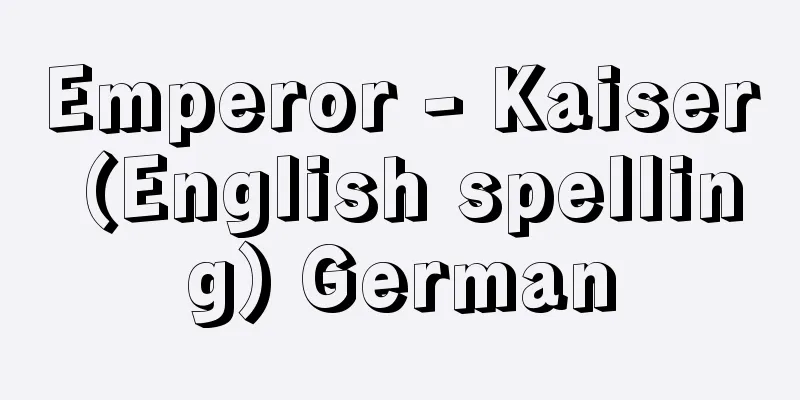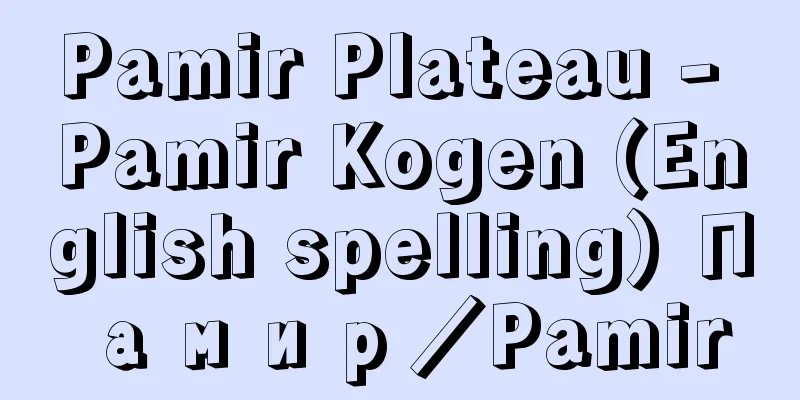Emperor - Kaiser (English spelling) German

|
The title of supreme secular ruler = monarch. [Shosuke Hirajo] EuropeThe title of emperor began with the Roman emperors after Augustus. In the early imperial period, known as the head of state, the emperor had the highest military command (imperium) and was merely the most important Roman citizen (princeps), but in the later imperial period after Diocletian, he gained absolute rule. This Roman imperial power was shared by the two emperors after the division of the empire into the Eastern and Western Roman Empires, and the Eastern Roman imperial power continued under the title Basileus until the fall of the Byzantine Empire (1453), but the Western Roman imperial power disappeared with the fall of the Western Roman Empire (476). The imperial coronation of Charlemagne in 800 AD was in a sense a revival of Western Roman imperial power, and the imperial power of the Holy Roman Empire since Otto I was also a revival of Carolingian imperial power, but these medieval European imperial powers contained Germanic and Christian elements in addition to Roman elements. The latter was the idea of the emperor as a secular protector of the entire Western Christian world, specifically of the Roman Papacy, and was symbolized by the tradition of the papal coronation of the emperor. While this element is an essential premise for understanding medieval imperial power, it also resulted in major problems for imperial power in the following two aspects. (1) Originally, the title of emperor included the claim that it was a worldwide rulership beyond the scope of nations or peoples. The Roman Empire ruled the entire Mediterranean world, and the Carolingian Empire ruled almost the entire Western Christian world, so there was no discrepancy between the emperor's actual rulership and its idealistic demands. However, in the case of the Holy Roman Empire, the bearer of imperial power was the German king, who could only practically rule Burgundy and Italy in addition to Germany, so a large discrepancy arose between the ideal of imperial power and reality. Medieval political theorists distinguished between the former and the latter, calling them the emperor's authority (auctoritas) and his power (potestas), but this authority had no meaning in real politics unless it was mediated by the fact that the emperor was the protector of the Roman papacy, which reigned over the entire Western Church in both name and reality. This is why, from the late Middle Ages to modern times, as the imperial power gradually lost its connection with the papacy, the imperial power itself lost its real meaning and eventually became a mere title of monarch. (2) The relationship between the imperial power and the papacy included the dependence of the former on the latter, as well as conflicting aspects that surfaced during the Investiture Controversy. After this conflict, the superiority of the papacy over the imperial power was strengthened, and Pope Innocent III extended the interpretation of the tradition of the papal coronation of the emperor to include the right to recognize the emperor, and interfered in the election of the German princes to the emperor. One of the reasons for the loss of the connection between the imperial power and the papacy after the late Middle Ages must be considered to be the movement of the imperial power to free itself from the constraints of the papacy. The Golden Bull of Charles IV essentially ignored the pope's right to recognize the emperor by establishing a legal procedure for the election of the emperor, and the tradition of the papal coronation of the emperor came to an end in the early modern period. Since the early modern period, imperial power has lost its real meaning and changed into a mere title of sovereign, resulting in a phenomenon in which sovereigns who had no historical or ideological connection to the Roman/medieval Christian imperial power -- such as the House of Habsburg, who became merely the Austrian sovereigns after the dissolution of the Holy Roman Empire (1806), and Russian sovereigns since Peter the Great, who claimed to be the successors of the Eastern Roman imperial power that disappeared with the fall of the Byzantine Empire -- could still bear the title of emperor, although some historical and ideological connection could still be considered. Examples of this include the sovereigns of the House of Hohenzollern after the unification of Germany, Napoleon, and his self-declared successor, Napoleon III. However, even among these imperial titles, the idea of supranational and supraethnic rulership that the title emperor originally had did not completely die out. The unified German Empire was nothing more than a union of the Kingdom of Prussia, the Kingdom of Bavaria, the Grand Duchy of Baden, and other state states, and the Emperor, who was also King of Prussia, was a monarch of a higher rank, while recognizing to a large extent the sovereignty of these state states.In Napoleon's case, he was not just the King of France, but also the Emperor of the Napoleonic Empire, which unified the various states he had conquered. [Shosuke Hirajo] ChinaThe title of the rulers of successive dynasties from Qin to Qing. It was founded in 221 BC when Qin Shihuang (the First Emperor) of Qin, who unified the six countries by merging them, decided on a report from his Prime Minister Wangwan. It is a direct combination of the "Emperor" from Taihuang, the supreme god among the Three Emperors (Emperor, Earth Emperor, and Taihuang), and the "Di" from the Five Emperors of antiquity (Records of the Grand Historian, Records of the First Emperor of Qin). However, it is thought that the intention of the King of Qin who adopted this title was to liken himself to the "Glorious Emperor," the supreme god of the universe and the ruler of all things, and to demonstrate to the world his status and authority far superior to any other ruler (emperor, son of heaven, king) who had appeared on earth up until that point. Furthermore, the titles "Shi Huangdi" and "Second Emperor" were posthumous titles, and during his reign he was simply referred to as "Emperor." The title of emperor was inherited by the Han dynasty, but the Han ruling system relaxed the prefecture and county system and added traditional feudal logic to it (county and country system), and the title of "Son of Heaven" that the Qin had abandoned was revived in response to the revival of Confucianism in a new guise in contrast to the Qin's exclusive devotion to Legalism. Thus, Han emperors came to use the two titles "Emperor" and "Son of Heaven", and used the title "Emperor" when reigning as the highest authority on earth and when worshiping the spirits of their ancestors, and "Son of Heaven" in diplomacy and when worshiping the gods of heaven and earth centered on Shangdi. This system of using both titles was continued by successive dynasties, and for example, the seals (jiin) symbolizing the status of the Tang emperors were composed of eight types: "Divine Treasure, Mandated Treasure, Emperor's Administrative Treasure, Emperor's Zhi Treasure, Emperor's Trust Treasure, Son of Heaven's Administrative Treasure, Son of Heaven's Zhi Treasure, and Son of Heaven's Trust Treasure," and each type had a different purpose of use. Also, monarchs from the Han dynasty onwards became "emperors" by establishing or inheriting political authority, and became "Sons of Heaven" by receiving the command of the Supreme Divine Being or inheriting the command, and only after going through this process could they reign as emperors, and it was for this reason that at least up until the Tang dynasty, two types of enthronement ceremonies were held in two stages. The imperial title established by the Qin dynasty and the ruling system with the emperor at its apex persisted for over 2,000 years until the Xinhai Revolution of 1911, and in this we can see the greatest distinctive feature of Chinese pre-modern history. [Isamu Ogata] "The Establishment of Imperial Rule" by Nishijima Sadao (included in "Iwanami Lecture Series on World History 4", 1970, Iwanami Shoten) " "The 'Family' and the State in Ancient China" by Ogata Isamu (1979, Iwanami Shoten)" [Reference] |Source: Shogakukan Encyclopedia Nipponica About Encyclopedia Nipponica Information | Legend |
|
最高の世俗的支配者=君主の称号。 [平城照介] ヨーロッパ皇帝の称号はアウグストゥス以降のローマ皇帝に始まる。前期帝政は元首政とよばれるように、最高の軍隊統帥権=インペリウムを有したほかは、ローマ第一の市民=プリンケプスであるにすぎなかったが、ディオクレティアヌス以降の後期帝政では、専制的支配権を有するようになった。このローマ皇帝権は、帝国の東・西ローマへの分裂以後、2人の皇帝によって分有され、東ローマ皇帝権はビザンティン帝国の滅亡(1453)まで、バシレウスBasileusという称号のもとに存続したが、西ローマ皇帝権は西ローマの滅亡(476)とともに消滅した。 紀元800年のカール大帝の皇帝戴冠(たいかん)は、ある意味で西ローマ皇帝権の復活であり、さらにオットー1世以降の神聖ローマ帝国の皇帝権も、カロリングの皇帝権の復活であったが、これら中世ヨーロッパの皇帝権には、ローマ的要素以外に、ゲルマン的要素とキリスト教的要素とが加わった。後者は、西欧キリスト教世界の全体に対する、具体的にはローマ教皇権に対する、世俗的権力による保護者としての皇帝という観念であり、教皇による皇帝戴冠の伝統がその象徴であったが、この要素は中世的皇帝権の理解の不可欠の前提をなすと同時に、次の二つの側面で、皇帝権に大きな問題を抱えさせる結果を生んだ。 (1)もともと皇帝の称号は、それが、国家や民族の範囲を超えた全世界的支配権である、という要求を含んでいた。ローマ帝国は全地中海世界を支配し、カロリング帝国も西欧キリスト教世界のほとんど全部を支配していたため、皇帝の現実的支配権と、その理念的要求とのずれは生じなかったが、神聖ローマ帝国の場合、皇帝権の担い手が、本国ドイツ以外にブルグントとイタリアのみを実質的に支配しえたにすぎないドイツ国王であったため、皇帝権の理念と現実との間に大きな食い違いが生じた。中世の政治理論家は、前者を皇帝の権威(アウクトリタス)とよび、後者をその権力(ポテスタス)とよんで区別するが、この権威は、皇帝が名実ともに全西欧教会に君臨するローマ教皇権の保護者であるという側面を媒介にしなければ、現実政治のうえでなんらの意味をももちえなかった。中世後期から近代にかけて、皇帝権が教皇権との結び付きをしだいに失うにつれて、皇帝権自体もその実質的意味を失い、ついには単なる君主の称号へと変化するのはそのためである。 (2)皇帝権と教皇権の間には、前者の後者に対する依存関係と並び聖職叙任権闘争で表面化する、両者の対立的側面も含まれた。この闘争以後、教皇権の皇帝権に対する優越性が強化され、インノケンティウス3世は、教皇の皇帝戴冠の伝統を皇帝承認権にまで拡大解釈し、ドイツ諸侯の皇帝選挙に干渉した。中世後期以降、皇帝権と教皇権の結び付きが失われた原因の一つには、皇帝権の側における、教皇権の束縛からの解放への動きも考えねばならない。カール4世の金印勅書は、皇帝選挙の法的手続を確立することにより、教皇の皇帝承認権を実質的に無視し、近世初頭には、教皇による皇帝戴冠の伝統も後を絶った。 近世以降、皇帝権は実質的内容を失い、単なる君主の称号に変化した結果、ローマ的=中世キリスト教的皇帝権と歴史的にも理念的にもなんらつながりをもたない君主――神聖ローマ帝国の解体(1806)以後オーストリアの君主にすぎなくなったハプスブルク家や、ビザンティン帝国の滅亡により消滅した東ローマ皇帝権の継承者を主張するピョートル大帝以降のロシアの君主の場合は、まだある種の歴史的・理念的関連性が考えられる――も、皇帝の称号を帯びるという現象が生じた。ドイツ統一後のホーエンツォレルン家の君主、ナポレオンとその後継者を自任するナポレオン3世の場合などがそれにあたる。だが、これらの皇帝の称号のなかにも、皇帝という名称が本来もっていた、超国家的・超民族的支配権という観念が、まったく死に絶えていたわけではない。統一後のドイツ帝国は、プロイセン王国、バイエルン王国、バーデン大公国その他諸領邦国家の統合体にほかならず、プロイセン国王をも兼ねる皇帝は、これら領邦国家の君主権をかなりの程度にまで容認したうえで、それより一段高い君主であり、またナポレオンの場合も、単にフランスの国王であるばかりでなく、征服した諸国家をも統合したナポレオン帝国の皇帝であった。 [平城照介] 中国秦(しん)から清(しん)に至る歴代王朝の君主の称号。紀元前221年、六国を併合して統一国家を実現させた秦王政(始皇帝)が、丞相王綰(じょうしょうおうわん)らの答申を裁定して創始した。直接的には三皇(さんこう)(天皇(てんこう)、地皇(ちこう)、泰皇(たいこう))のうちの最高神である泰皇の「皇」と、上古の五帝の「帝」とをあわせたものであるが(『史記』秦始皇本紀)、この称号を採択した秦王の意図は、宇宙の最高神であり万物の総宰者である「皇皇(煌煌(こうこう))たる上帝」に自らを比擬し、それまで地上に現れたどの君主(帝、天子、王)よりもはるかに優越した地位と権威を天下に示すことにあったと考えられる。なお「始皇帝」「二世皇帝」の号はいずれも死後にたてられる諡号(しごう)(おくりな)であり、在位中は「皇帝」と称するのみであった。 皇帝の号は漢王朝にも継承されたが、漢の支配体制は、郡県制を緩めてこれに伝統的な「封建」の論理を加味したもの(郡国制)であり、また法家一辺倒の秦に対して儒家思想が新しい装いのもとに復興してきたことに応じて、秦が捨てた「天子」の称号がふたたび復活した。かくて漢の皇帝は、「皇帝」と「天子」という二つの称号をあわせ称するようになったのであり、地上における最高権力者として君臨するとき、および祖先の霊を祭る場合には「皇帝」、外交の場合、および上帝を中心とする天地の諸神を祭るときには「天子」の号をそれぞれ用いた。この両号併用の制度は、以降の歴代の王朝でも受け継がれ、たとえば唐の皇帝の場合、その地位を象徴する璽印(じいん)は「神宝、受命宝、皇帝行宝、皇帝之宝、皇帝信宝、天子行宝、天子之宝、天子信宝」の八つで構成され、それぞれ使用目的が分別されていた。また漢代以降の君主は、政治的権威を確立ないしは継承して「皇帝」となり、上帝の命を受けて、または受命したことを継承して「天子」となり、この手続を経て初めて皇帝として君臨できたのであり、少なくとも唐代に至るまでの時代において、2次にわたる2種類の即位式が挙行されたのは、この理由による。 秦の創始した皇帝の称号、および皇帝を頂点に置く支配体制は、1911年の辛亥(しんがい)革命に至るまでの2000余年の間存続したのであり、この点に中国前近代史上の最大の特質をみいだすことができる。 [尾形 勇] 『西嶋定生著「皇帝支配の成立」(『岩波講座 世界歴史4』所収・1970・岩波書店)』▽『尾形勇著『中国古代の「家」と国家』(1979・岩波書店)』 [参照項目] |出典 小学館 日本大百科全書(ニッポニカ)日本大百科全書(ニッポニカ)について 情報 | 凡例 |
<<: Emperor Gao (English spelling)
Recommend
Saburo Usami - Usami Saburo
...A medieval samurai family whose main territory...
Ganghwa Island Incident
The battle that took place in 1875 (Meiji 8) betw...
Abilympic (English spelling)
From ability + Olympic, this is a competition wher...
Monoacid-Base - Issan Enki
A base that produces one hydroxide ion per chemic...
Kurama Tengu
The title of a Noh piece. A kiri-noh piece (→ ono-...
Zhang Jun; Chang Chün
[Born] Shosei 4 (1097) [Died] August 28, 1164 (Ryū...
Arius maculatus
A marine fish of the order Siluriformes and family...
Heat rash
A colloquial name for miliaria or miliaria eczema...
Vocoder - Vocoder (English spelling)
In a broader sense, it refers to a system that an...
Cyclea insuloris (English spelling)
...The ingredients are cephalatine, berbamine, me...
Horowitz
A Ukrainian-born American pianist. One of the most...
Yonkers - Yonkers (English spelling)
It is a suburb of New York City in the southeaste...
Taiko Land Survey
This was a land survey carried out by Toyotomi Hi...
Senecio (English spelling)〈Latin〉Senecio
A general term for plants in the genus Senecio (Se...
Rhacomitirum lanuginosum (Hedw.) Brid.
A moss of the Grimoniaceae family. It is distribut...









